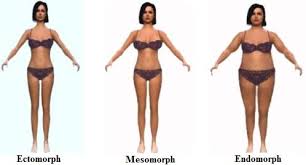
Once upon a time, people acknowledged the fact that there were actually different, innate body types. I call them the "morphs": ectomorphs, mesomorphs and endomorphs.
Ectomorphs are fine-boned, lean individuals who have trouble gaining weight (see
this post). Mesomorphs are athletic, have well-defined muscle mass, the typical male (upside-down triangle) or female (hourglass) body shape, gain muscle easily but also gain weight somewhat more easily than ectomorphs. Endomorphs have "soft" bodies, gain weight easily and their muscle mass is less well-defined. Of course, most people are a combination of either ecto/mesomorphs or meso/endomorphs. An ecto/endomorph would be a contradiction in terms.
Once upon a time, there were also body charts that presented a range of healthy weights for an individual. I found one that calculated that a large-boned woman measuring 4'10" could weigh anywhere from 118 to 131 pounds. That's quite a range. (The large-boned determination for this calculation was based on wrist circumference). Let's contrast this with what the sacred BMI tells us: this same woman--no matter whether she is large, medium, or small-boned--should weigh no more than 119 pounds. Past 119 pounds, she is overweight. At 131 pounds, she is squarely in the middle range of the BMI classification for overweight.
Now, some may say that we should follow the BMI's ruling. After all, the lower the weight the better. Right? [sarcasm alert]. Many may say that pleading the "large bones" defence is simply a cop-out. But how can one number encompass the endless variety of bodies we see in this world of ours? How can we make abstraction of the differences that exist in body morphology between a "typical" Northern European and a "typical" Asian? How can we make abstraction of the fact that--even when we factor out weight--some women have larger breasts or wider hips than others?
We have forgotten the morphs and with it, we have instilled in people (including, sadly, too many medical professionals) the insane notion that salvation and success lie in one number and one number only: one's BMI.
In my travels around the weight-o-sphere, I have frequently come across people who measure their success--but usually their failure--by their ability or inability to grab the brass ring of the below 25 BMI. Tragically, many people who have made great strides in improving their health through reasonable physical activity and healthy eating (not dieting) feel an all-encompassing sense of failure because the "correct" BMI number remains outside of their grasp. Often, in despair, they give up totally on their healthier habits when they realize that the "right" BMI is just not in the cards for them, despite the fact that they have actually succeeded in making a healthier life for themselves.
I say "bring back the morphs" and with them the recognition that people don't all have to look the same or share the same sacred number to be healthy!
